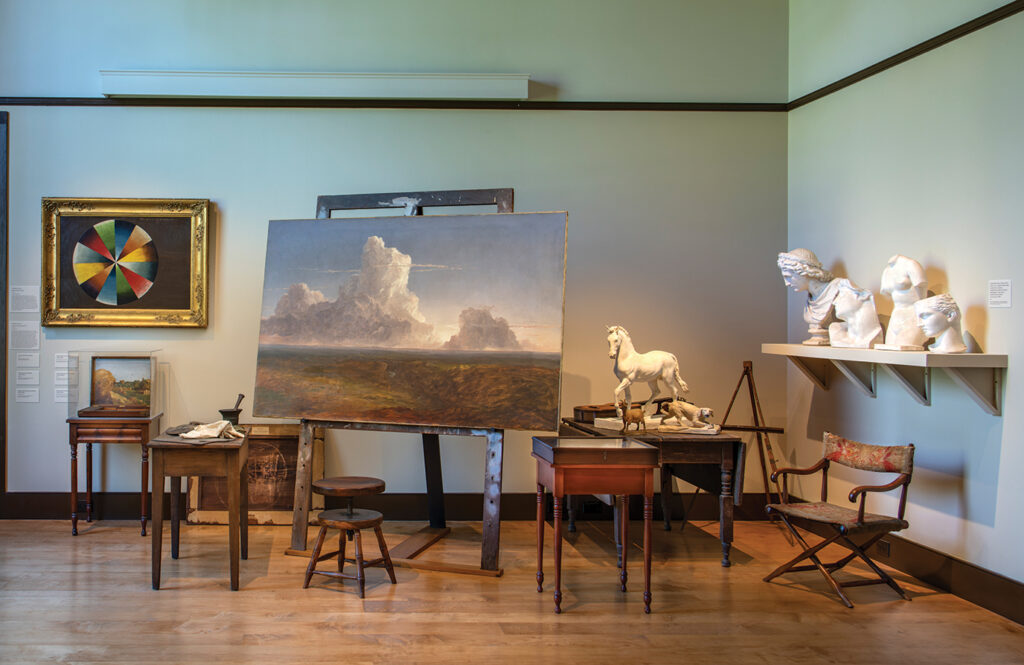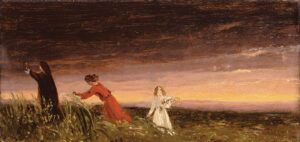Subscribe to Our Newsletter
Preserving the Past

The Albuquerque Museum of Art gives visitors an inside look of the life an artist with its exhibition Thomas Cole’s Studio: Memory and Inspiration.
By James D. Balestrieri
If an artist’s studio is an extension of the artist’s creative mind—the space where the artist’s art is conceived, worked out and brought to fruition—then preserving and restoring artists’ studios ought to be a top priority. In the last few decades, with programs such as the National Trust for Historic Preservation’s Historic Artists’ Homes and Studios coalition, and the realization across the board that studios do indeed offer extraordinary insights, this idea has come into its own.

Study for The Cross and the World—The Pilgrim of the World on his Journey, 1846-7. Oil on canvas, 12 x 18 in.
Albany Institute of History & Art Purchase, 1943.82
With astounding foresight, Hudson River School founder Thomas Cole’s widow, children and sister preserved his “New Studio” keeping it just as he left it for decades after his untimely death in 1848, at the age of 47. As artist Jasper Cropsey wrote after a visit in 1850, “it seemed as if Mr. Cole would…be in in a few minutes, for every thing remains as when he last left painting…. Though the man has departed, yet he has left a spell behind him that is not broken.” Many artists made the pilgrimage to Catskill, New York, to pay their respects to Cole. They also went, in very important ways, to find inspiration for their own works in the unsold and unfinished works; in the stacks of drawings; in his paint box, palette and brushes; in his color wheel and the plaster casts he used as models; in the interior space itself that Cole designed with light in mind; and in the surrounding landscape that looked east toward the Hudson Valley and west to the rising Catskill Mountains.
Because his family preserved his studio, Thomas Cole’s influence lived on beyond his passing. The reconstruction of the New Studio and the exhibition, “Thomas Cole’s Studio: Memory and Inspiration”, now on view at the Albuquerque Museum of Art, extends the artist’s reach once again by allowing it to be broadcast beyond the confines of the Thomas Cole National Historic Site.
Cole came into the world in 1801 in the English city of Bolton-le-Moors, which was one of the dark hearts of the early Industrial Revolution. Bolton’s textile mills polluted the air and water. Their fires burned day and night and the millworkers’ living quarters were squalid and overcrowded. When he was 11, the “Luddites”, hand weavers led by Ned Ludd, rose up and destroyed Bolton’s mechanical looms because the machines threatened to render their skills obsolete. Mill owners and the government responded with violence in kind. Cole bore witness to riots and reprisals as they played out against the backdrop of the infernal fires. These impressions would deeply influence his art, both in his love for the natural world and in his deep suspicion of humankind’s ambitions and hubris.

Life, Death, and Immortality, 1844. Oil on wood panel, 5 7⁄8 x 12 in.
Wadsworth Atheneum Museum of Art, Thomas L. Archibald Fund, 2008.8.1
Cole began to practice art as an apprentice engraver in Liverpool, accompanied his family to Ohio in 1818 and then made his way to Philadelphia. Perhaps because of the contrast between what he saw as the Edenic “American scenery” and the human-made fires of Bolton, Cole began to paint, first in watercolors and then in oils. During a move to Pittsburgh and back to Philadelphia in 1823 and 1824, the young artist filled sketchbooks with anthropomorphic drawings of trees that would shape his art and his view of the world. Cole came to see trees “like men, differing widely in character,” and in later years, in his beloved Catskills, he would view the felling of the forests to fuel the American empire as a sin against a divine dispensation—the wilderness that made America a new Eden. To him, taming and destroying nature went against the better angels of human nature. The reckoning he foresaw and feared would form one of the principal themes of his work and make him an early advocate for the environment.
In 1825, Cole moved with his family to New York City. Later that year, his made his first journey up the Hudson to paint. One of the paintings from this trip was purchased by John Trumbull—painter of the Declaration of Independence and president of the American Academy of the Fine Arts. When Trumbull also proclaimed that Cole was destined to become the key interpreter of the American landscape in art, the young painter’s star was on the ascendant. In 1827, and thereafter, he would maintain a studio at a farm named Cedar Grove in Catskill. Four years later, Cole returned to Europe to study and to try to build on his early success. Meetings with J.M.W. Turner and other painters—in their studios—as well as his trips to museums to view the Old Masters firsthand—Claude Lorrain in particular—proved to be formative experiences. At the end of 1832, Cole returned to New York. A year later, he would settle in Catskill and would marry Maria Bartow, niece of the owner of Cedar Grove, in 1836.

Landscape with Clouds, 1846-7. Oil on canvas, 48 x 72 in.
Private Collection.
Franklin Kelly’s exhibition catalogue essay lays out Cole’s vision for his art, “[H]istory paintings—works that depicted human figures and took their themes from history, mythology, literature, religion, or other sources—were at the apex, and demanded the greatest intellectual ability, imagination, and artistic creativity. Cole understood this, and was determined to create ‘a higher style of landscape’ that would integrate narrative elements with landscape to convey complex ideas about human beings and their place in the world. Figures and human creations would play roles in these narratives, but so too would elements from nature—trees, rocks, streams, mountains, clouds, light, time of day, and seasons. Landscape painting would be fused with history painting and elevated accordingly.”
Cole’s “higher style of landscape” not only embraced architecture as a subject for painting but also as an artform and a medium that could elevate the mind and find harmony with and in nature. Many of his paintings, such as the Course of Empire quintet and the late Study for the Cross and the World—The Pilgrim of the World on his Journey, feature the artist’s interest in classical structures as emblems of humankind’s highest worldly expressions.
Cole drew and redrew detailed architectural renderings for an Italianate villa and studio that he envisioned on the grounds of Cedar Grove, including pillared porticoes and a tower that would look out onto the Catskills. Though the villa was never built, echoes of its design—though Moorish rather than Italian—resound in Olana, the home and studio of Frederic E. Church that rises across the Hudson from Cedar Grove, just a healthy walk away. Cole’s most eminent pupil, Church would frequent the New Studio after his teacher’s passing and helped the family sell works from the New Studio as well as earlier works that had never sold like Tornado in an American Forest, which dates to 1831. Almost a study for the kinds of divine whirlwinds you find in his didactic paintings, Tornado in an American Forest is, ironically, the kind of landscape that found favor after Cole’s death, that is, pure landscape without an obvious moral function or attached narrative. And yet, while the minuscule figures seek partial shelter from the oncoming storm in the lee of a blasted tree, a look behind the blasted tree’s twin, at left, reveals a shadowy, anthropomorphic figure, a doppelganger of sorts. Light and dark, the righteous path and the path to perdition, these are cornerstones of Cole’s aesthetic, even when they aren’t readily apparent.
Another of Cole’s notable works was Prometheus Bound, a large study for an even larger oil Cole sent to Britain to be considered as part of the design of a new Parliament—Cole played his “born in England” card to gain admission. The larger painting was rejected for the design, probably because it leaned too heavily on landscape and not enough on history, but Prometheus was a dominant symbol during Cole’s lifetime and his choice is not surprising.

Thomas Cole’s Studio: Memory and Inspiration, installation view.
© Peter Aaron OTTO
The myth of the Titan who stole fire from heaven and gave it—as well as culture and free will—to humankind and was chained to a mountain by Zeus for his transgression forms the subtitle, for example, of Mary Shelley’s Frankenstein, or The Modern Prometheus. The Greek play Prometheus Bound, by Aeschylus, was translated into English many times during the period—Thoreau’s being perhaps the most notable. Prometheus was presented is various guises: as a precursor of Christianity, as a symbol of the endurance of enslaved peoples against injustice, as a cautionary tale against hubris, and as an avatar of free will and the triumph of the human spirit, even against the will of heaven.
In Cole’s painting Prometheus Bound, Prometheus is chained to a cold, rocky crag. Birds attack him, as they do every day of his confinement, before he falls into an abyss and wakes to find himself bound once more. In the final version, Cole removes the bird—the narrative element—and places the morning planet, Jupiter, aka Zeus, in the sky, gloating over his captive. Ice, rock; sky, earth; dark, light—Cole here is concerned with all the elements except water. There is no water other than what falls from the cloud that halos a peak at left arrayed against a Titan, who is small beside them. Injustice seems to be Cole’s take on the Promethean theme.
The imposing Landscape with Clouds, left unfinished in Cole’s studio, presses the artist’s interest in natural forms. While at first appearing to be a pure landscape, Cole scratched in some figures, an angel and child, with what looks to have been the back of a brush. Study for Catskill Creek, on the other hand, dispenses entirely with human form, anticipating the landscapes of Sanford Robinson Gifford and others in the next generation of Hudson River School painters.
In a final nod to allegory, the last painting Cole completed, The Good Shepherd, finds the artist in an Arcadian mode, almost nostalgic for the biblical and mythical scenes that launched his career. Still, the foreground Eden is shadowed by distant wilderness. One can imagine Prometheus bound to the mountains at right, unrefreshed by the rain that rings the lower peak.
Perhaps, even in the brief time he painted in his New Studio, Cole was beginning to move away from the sequential, narrative paintings that would fall out of favor after his death. When The Cross and the World failed to come together, Cole turned to other subjects and ideas. The New Studio allowed him to attempt larger canvases, yet the figures seemed to be getting smaller or vanishing altogether. As we do whenever an artist dies prematurely—especially when we can visit the home and studio—we wonder what Thomas Cole would have done had he lived, for instance, to witness the Civil War and its aftermath. Would he have returned to didactic painting with a vengeance, or would he have gone back to his trees and found spiritual comfort in their personalities? The artists who visited the New Studio after Cole’s death surely wondered this as well.




























